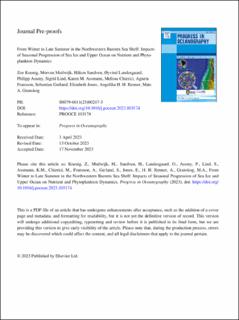From Winter to Late Summer in the Northwestern Barents Sea Shelf: Impacts of Seasonal Progression of Sea Ice and Upper Ocean on Nutrient and Phytoplankton Dynamics
| dc.contributor.author | Koenig, Zoe Charlotte | |
| dc.contributor.author | Muilwijk, Morven | |
| dc.contributor.author | Sandven, Håkon Johan | |
| dc.contributor.author | Lundesgaard, Øyvind | |
| dc.contributor.author | Assmy, Philipp Kurt Wolf | |
| dc.contributor.author | Lind, Sigrid Gjessing | |
| dc.contributor.author | Assmann, Karen | |
| dc.contributor.author | Chierici, Melissa | |
| dc.contributor.author | Fransson, Agneta | |
| dc.contributor.author | Gerland, Sebastian | |
| dc.contributor.author | Jones, Elizabeth Marie | |
| dc.contributor.author | Renner, Angelika | |
| dc.contributor.author | Granskog, Mats | |
| dc.date.accessioned | 2023-11-27T13:25:05Z | |
| dc.date.available | 2023-11-27T13:25:05Z | |
| dc.date.created | 2023-11-23T10:18:03Z | |
| dc.date.issued | 2023 | |
| dc.identifier.issn | 0079-6611 | |
| dc.identifier.uri | https://hdl.handle.net/11250/3104817 | |
| dc.description.abstract | Strong seasonality is a key feature of high-latitude systems like the Barents Sea. While the interannual variability and long-term changes of the Barents Sea are well-documented, the seasonal progression of the physical and biological systems is less known, mainly due to poor accessibility of the seasonally ice-covered area in winter and spring. Here, we use an extensive set of physical and biological in situ observations from four scientific expeditions covering the seasonal progression from late winter to late summer 2021 in the northwestern Barents Sea, from fully ice-covered to ice-free conditions. We found that sea ice meltwater and the timing of ice-free conditions in summer shape the environment, controlling heat accumulation, light and nutrient availability, and biological activity vertically, seasonally, and meridionally. In March and May, the ocean north of the Polar Front was ice-covered and featured a deep mixed layer. Chlorophyll-a concentrations increased from March to May along with greater euphotic depth, indicating the beginning of the spring bloom despite the absence of surface layer stratification. By July and in September, sea ice meltwater created a shallow low-density surface layer that strengthened stratification. In open water, chlorophyll-a maxima were found at the base of this layer as surface nutrients were depleted, while in the presence of ice, maxima were closer to the surface. Solar heating and the thickness of the surface layer increased with the number of ice-free days. The summer data showed a prime example of an Arctic-like space-for-time seasonal variability in the key physical and biological patterns, with the summer situation progressing northwards following sea ice retreat. The amount of sea ice melt (local or imported) has a strong control on the conditions in the northwestern Barents Sea, and the conditions in late 2021 resembled pre-2010 Arctic-like conditions with high freshwater content and lower ocean heat content. | en_US |
| dc.language.iso | eng | en_US |
| dc.subject | Marin irradians | en_US |
| dc.subject | Marine irradiance | en_US |
| dc.subject | Barentshavet | en_US |
| dc.subject | Barents Sea | en_US |
| dc.subject | Fytoplankton | en_US |
| dc.subject | Phytoplankton | en_US |
| dc.subject | Sjøis | en_US |
| dc.subject | Sea ice | en_US |
| dc.subject | Næringssalter | en_US |
| dc.subject | Nutrients | en_US |
| dc.title | From Winter to Late Summer in the Northwestern Barents Sea Shelf: Impacts of Seasonal Progression of Sea Ice and Upper Ocean on Nutrient and Phytoplankton Dynamics | en_US |
| dc.title.alternative | From Winter to Late Summer in the Northwestern Barents Sea Shelf: Impacts of Seasonal Progression of Sea Ice and Upper Ocean on Nutrient and Phytoplankton Dynamics | en_US |
| dc.type | Peer reviewed | en_US |
| dc.type | Journal article | en_US |
| dc.description.version | acceptedVersion | en_US |
| dc.subject.nsi | VDP::Oseanografi: 452 | en_US |
| dc.subject.nsi | VDP::Oceanography: 452 | en_US |
| dc.source.journal | Progress in Oceanography | en_US |
| dc.identifier.doi | 10.1016/j.pocean.2023.103174 | |
| dc.identifier.cristin | 2200756 | |
| dc.relation.project | Norges forskningsråd: 276730 | en_US |
| dc.relation.project | EC/H2020/CRiceS | en_US |
| cristin.ispublished | true | |
| cristin.fulltext | postprint | |
| cristin.qualitycode | 1 |
Tilhørende fil(er)
Denne innførselen finnes i følgende samling(er)
-
Articles [3009]
-
Publikasjoner fra CRIStin [3056]
